
May Data - July Reporting
MICHIGAN UNEMPLOYMENT RATE DECLINES IN MAY
On a seasonally adjusted basis, Michigan’s unemployment rate inched down by one-tenth of a percentage point to 3.7 percent between April and May.
The U.S. unemployment rate increased by three-tenths of a percentage point to 3.7 percent during May. This marks the first time since June 2018 that Michigan’s unemployment rate matched the national unemployment rate. Over the year, the national jobless rate edged up by one-tenth of a percentage point, while the statewide rate fell by three-tenths of a percentage point.
Michigan labor force levels rose by 0.5 percent during May, while U.S. labor force levels were little changed, inching up by only 0.1 percent. Statewide employment advanced by 0.7 percent over the month, contrary to the reduction of 0.2 percent observed nationally. Total unemployment in Michigan fell by 3.8 percent,
while total unemployment in the U.S. jumped by 7.8 percent.
Over the year, Michigan’s workforce rose by 1.0 percent, which was 0.5 percentage points below the national labor force increase of 1.5 percent. Michigan’s employment total increase of 1.3 percent between May 2022 and May 2023 was comparable to the employment advance exhibited nationally (+1.5 percent). Statewide unemployment totals receded by 6.8 percent over the year, while nationwide unemployment totals rose by 2.0 percent.
REIMA NASSER
Economic Analyst

Source: Local Area Unemployment Statistics, Michigan Center for Data and Analytics, Michigan Department of Technology, Management & Budget
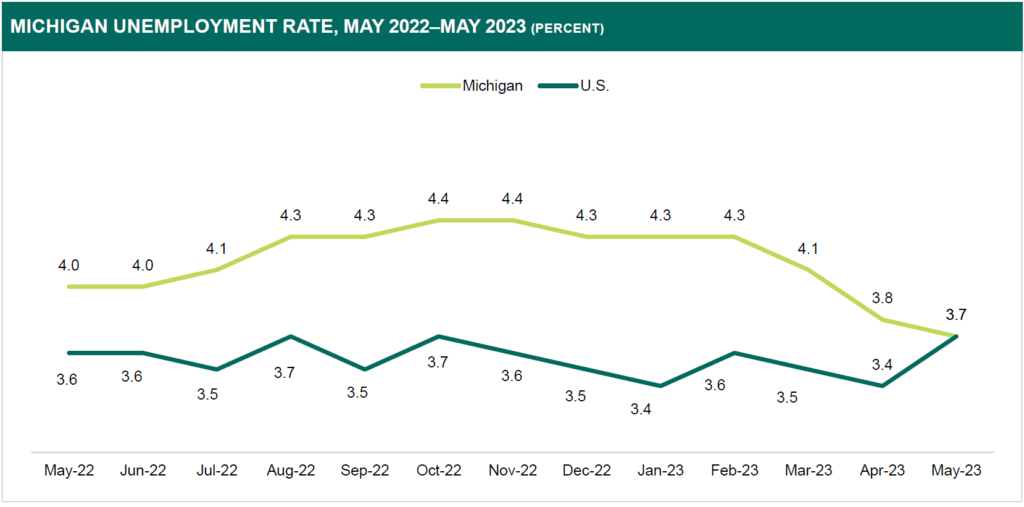
Source: Local Area Unemployment Statistics, Michigan Center for Data and Analytics, Michigan Department of Technology, Management & Budget
STATEWIDE NONFARM PAYROLL JOBS RISE FOR SEVENTH CONSECUTIVE MONTH
For the seventh consecutive month, total nonfarm payroll jobs on the statewide level recorded an increase in employment, on a seasonally adjusted basis. Michigan payroll jobs moved up by 14,500, or 0.3 percent, in May, the largest over-the-month numeric advancement during 2023. Nonfarm employment across the state was only 0.2 percent lower than its February 2020 pre-pandemic job level.
Nationally, total nonfarm payroll jobs rose by 0.2 percent over the month, 0.1 percentage points below the Michigan average for May. This job increase marked the 29th straight month of recorded job gains for the United States. Additionally, on the nationwide level, total nonfarm employment has now surpassed its February 2020 pre-pandemic level for one consecutive year.
In May, eight of the 11 seasonally adjusted statewide super-sector industries recorded job growth over the month, led by Leisure and hospitality (+5,500); Professional and business services (+2,900); and Trade, transportation, and utilities (+2,400). Both the Mining and logging and Financial activities major industries remained unchanged over the month. Furthermore, only one major industry sector in Michigan, Other services, noted job loss (-300) during May.
On the nationwide level, every major industry sector advanced over the month, with the exception of the Information (-9,000) and Manufacturing (-2,000) sectors. Service providing jobs outpaced Goods producing jobs during May due to strong gains within the Private education and health services (+97,000), Professional and business services (+64,000), and Leisure and hospitality (+48,000) industry sectors.
Jobs Increase for Many Statewide Industries Over the Year
Total nonfarm payroll jobs advanced by 82,100, or 1.9 percent, over the year, as well as in most major industry sectors in Michigan. Since May 2022, nine of Michigan’s 11 major industry sectors recorded job additions, led by Government (+19,800), Private education and health services (+19,200), and Leisure and hospitality (+17,500). On a percentage basis, notable job gains were recorded within the Mining and logging and Construction (+4.2 percent) major industry sectors. Conversely, both the Financial activities (-5,700) and Other services (-2,600) sectors noted job declines since year-ago levels.
Over the year, every major industry sector on the national level recorded job additions, which were led by Private education and health services, Leisure and hospitality, and Professional and business services. Service providing jobs rose by approximately 3.6 million over the year.
May Job Change Rates Increase in Most Michigan Metro Areas
In May, 12 of Michigan’s 14 Metropolitan Statistical Areas (MSAs) noted not seasonally adjusted job additions over the month. Only two regions, Saginaw and Ann Arbor, recorded rate declines over the month. Although the Detroit MSA was the only area to produce a higher monthly job change rate than Michigan, 10 of the other 11 metro areas recorded a rate of change higher than the national average.
Total employment in numerous major industry sectors, such as Mining, logging, and construction; Trade, transportation, and utilities; Professional and business services; Leisure and hospitality; and Other services, remained either unchanged or increased in every metro area in Michigan during May.
Government jobs declined in a majority of Michigan metro areas, following their typical, seasonal trend for May.
JIM BIRNEY
Economic Analyst
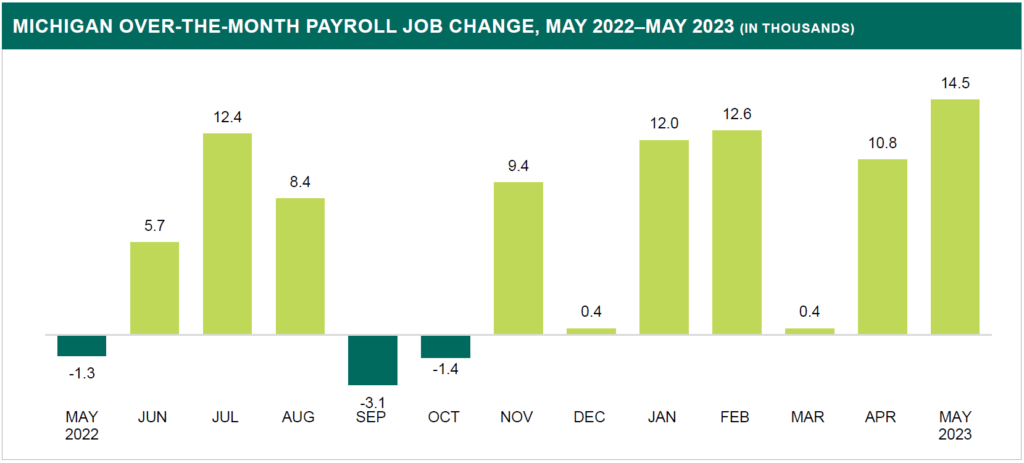
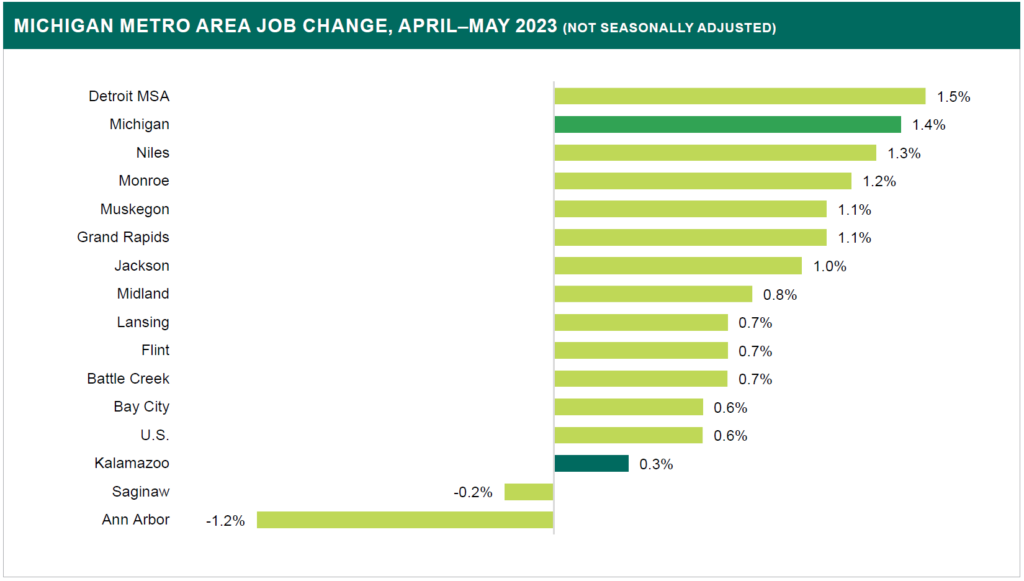
Source: Current Employment Statistics, Michigan Center for Data and Analytics, Michigan Department of Technology, Management & Budget
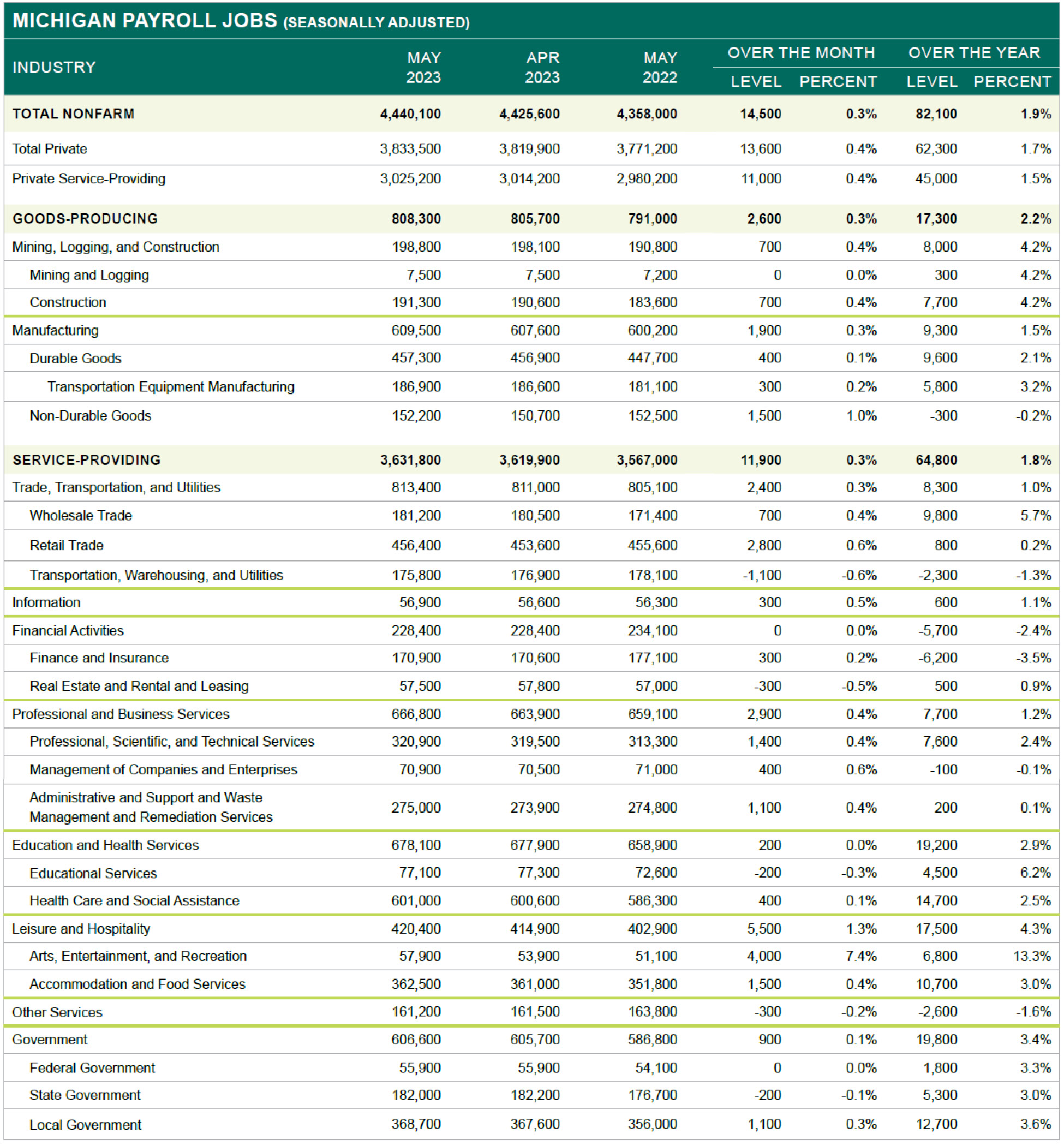
Source: Current Employment Statistics, Michigan Center for Data and Analytics, Michigan Department of Technology, Management & Budget
APRIL JOB OPENINGS INCREASE, WHILE LABOR TURNOVER TRENDS DOWNWARD
The job openings rate in Michigan increased from 5.4 percent in March to 5.7 percent in April according to the latest release of the statewide Job Openings and Labor Turnover Survey (JOLTS). Job openings along with hires (3.8 percent) were the only survey indicators to increase over the month. The separations rate (3.3 percent) quits rate (2.0 percent), layoffs and discharges rate (1.3 percent), and the labor turnover rate (7.1 percent) all declined over the month.
Job Openings Experience a Small Increase
Job openings increased from 254,000 to 269,000 (+15,000) in April. This translated to a 0.3 percentage point growth in the job openings rate, moving from 5.4 percent in the previous month to 5.7 percent in the latest release. Michigan had the 9th lowest job openings rate out of all states and was below the national rate (6.1 percent).
Hires Remains Virtually Unchanged
The rate of hires stayed virtually the same in April, increasing by 0.1 percentage point to 3.8 percent. This growth was reflected in approximately 6,000 more employees being hired in April than in the prior month. Michigan was below the national hires rate at the time (3.9 percent) and was the state with the 13th lowest rate of hires.
Separations Decline Marginally
Similar to other indicators, the separations rate experienced a relatively negligible change in April, dropping 0.2 percentage points to 3.3 percent. Numerically, this translated to 10,000 less employees being separated from their jobs in April. Michigan was below the national separations rate during the same time (3.7 percent).
The relatively small drop in separations was driven by shifts in both factors affecting this metric: quits and layoffs and discharges. The quits rate was virtually unchanged, declining by 0.1 percentage point to 2.0 percent. The rate of layoffs and discharges also dropped by 0.1 percentage point, from 1.3 percent in March to 1.2 percent in April.
Labor Turnover Trending Downward
The unemployed persons to job openings ratio is a metric that measures the current number of unemployed people relative to the availability of jobs. As mentioned earlier, this ratio recorded a high of 0.81, or eight unemployed persons per ten job openings. This was the highest this ratio has been since April 2021 (0.90). This can be attributed to both job openings and unemployment decreasing over the month, moving these two indicators closer to one another. The current recorded ratio makes the third consecutive month that this indicator has risen. With the ratio increasing for three consecutive months, it raises the possibility of a one-to-one relationship between job seekers and job openings in the future, meaning there would be an equal number of unemployed individuals and available jobs.
KRYSTAL JONES
Economic Analyst
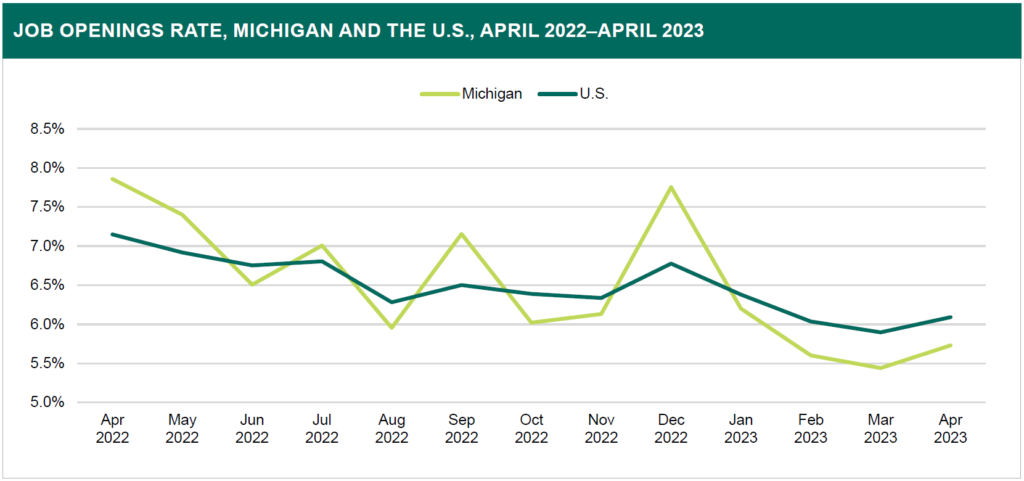
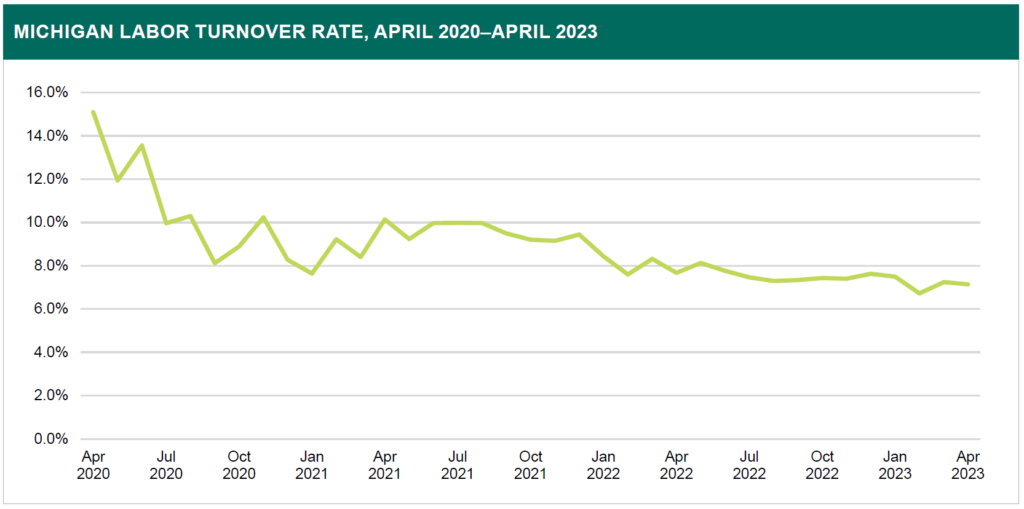
Source: Job Openings and Labor Turnover Survey, U.S. Bureau of Labor Statistics
Disclaimer
The Above Information was created and disseminated by the Department of Technology, Management, and Budget and the Bureau of Labor Market Information and Strategic Initiatives from the State of Michigan. Specialized Staffing does not hold any rights or ownership to this content. For more information, please contact your Michigan Bureau of Labor Representative.
